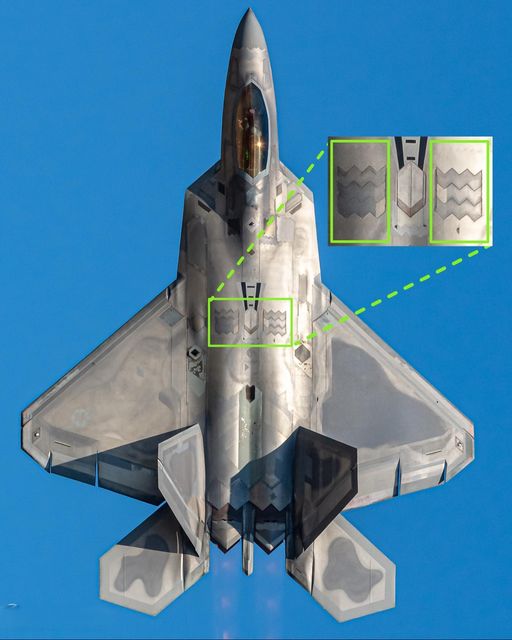The distinctive sawtooth sections on the top of the F-22 Raptor's fuselage play a crucial role in its sophisticated air management system. These structures are not merely for aesthetic purposes; they are integral to ensuring the aircraft's engines receive the appropriate amount of air across a wide range of operational conditions, including varying speeds, altitudes, and angles of attack.

The F-22 Raptor, renowned for its advanced stealth and performance capabilities, relies on fixed air inlets to channel air to its Pratt & Whitney F119-100 engines. However, maintaining optimal engine performance requires a precise balance of air volume, pressure, and speed, which can be challenging given the dynamic flight conditions the Raptor encounters. To address this, the aircraft is equipped with overpressure doors that manage excess air intake effectively.
These overpressure doors are designed to open and release surplus air when the engine's airflow requirements are lower than what the inlets can handle for stable operation. This situation typically arises during scenarios where the aircraft needs to decelerate rapidly from supercruise speeds, which are high-speed flight conditions sustained without the use of afterburners. When the throttles are pulled back in such scenarios, the engines demand less air. To prevent an overabundance of air from entering the engines, which could disrupt their performance, the bypass doors open to dump the extra air overboard.
Importantly, these bypass doors do not increase the airflow directly to the engines. Instead, they regulate the inlet airflow, ensuring that only the necessary amount of air is supplied to maintain engine stability and efficiency. This mechanism is crucial for the F-22's performance, as it allows the aircraft to adapt to rapid changes in flight conditions without compromising engine function.
The innovative design of the F-22's air intake system, including the sawtooth sections and overpressure doors, underscores the aircraft's advanced engineering. By managing airflow precisely, the Raptor can achieve superior performance, whether cruising at high speeds, maneuvering aggressively, or descending rapidly. This capability is essential for maintaining the stealth and agility that define the F-22 as one of the most formidable fighters in the world.
In addition to their functional role, the sawtooth sections contribute to the overall aerodynamic efficiency and stealth profile of the F-22. They help to reduce radar cross-section and manage airflow around the fuselage, further enhancing the aircraft's stealth capabilities. This combination of aerodynamic efficiency and stealth performance ensures that the F-22 remains at the forefront of modern aerial combat technology.
In summary, the sawtooth sections on the F-22 Raptor's fuselage are a key component of its sophisticated air management system, designed to regulate airflow to the engines under various flight conditions. This system, including the overpressure doors, allows the F-22 to maintain optimal engine performance, contributing to its exceptional speed, agility, and stealth characteristics.
